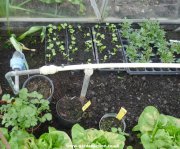Categories
Calendars
Guides
Reviews
Archive
Gallery
Articles
Ask Our Gardening Expert
HOW TO GROW GREENHOUSE TOMATOES - NAVIGATION
How much and how often to water tomato plants, and other
plants, is not an exact science. There are too many variables to lay
down hard and fast rules. The size of the plants, their vigour, the type
of compost / soil, temperatures and amount of light will all affect watering requirements.
One of the most frequently asked questions about
greenhouse tomatoes is how often and how much to water. The only true
answer is that it all depends on the too many variables to give a hard
and fast single answer. But our estimate for average conditions is that
each greenhouse plant will require 1.1 litre / 2 pints of water per
plant per day. The key variables which will affect that estimate are: Temperature / sun - in cool cloudy conditions,
water requirements will be about half the above estimate; in warm full
sun conditions water requirements will be about 50% more. Growing method - if grown directly in the soil, then watering
requirements will be less, depending on the soil type. If growing in
bottomless pots with a gravel type base then watering requirements will
be slightly more. Aside from the very imprecise estimates given above two
other methods can and should be used. First is visual examination of the
soil. It should be moist but not water-logged. Examine not only the
surface of the soil but also the dampness of the soil 5cm / 2in below.
When growing tomatoes in bottomless pots especially, the top surface of
the soil can look dry but just 3cm / 1in below the surface, the compost
can very moist. The second indicator of water needs is the appearance of
the plant. If it is wilting then, disease aside, it probably needs
watering. For more long term watering requirement, it is common for
over-watered tomato plants to have lighter green foliage compared to
normal. The lower leaves will start to yellow. Reduce watering if this
is the case. Under-watered tomato plants tend to have darker than
normal foliage which is harder and in severe cases it begins to go crisp.
Increase watering in these cases. Watering frequency - little but often is the best
rule. This will ensure an even supply of water which is good for tomato
plants. Infrequent applications of large amounts of water will cause the
skin of the fruits to split. MULCHING - when growing tomatoes directly in the
soil or in bottomless pots, a layer of mulch on the surface will help
retain water and reduce the need for watering. Black plastic sheet can
be used or a 3 to 5cm / 1 to 2 in layer of chipped bark for a more
attractive finish. Gravel is another alternative for pots. AUTOMATIC WATERING SYSTEMS - there is a wide
range of watering systems from the various horticultural companies
online and in garden centres and diy stores.
On the left (click to enlarge the picture) is a basic system. It
consists of an tap attachment which supplies water at timed
intervals. The water is piped to the greenhouse and small
nozzles spray water over the soil.
The nozzles can be set high or low as required. For reliable and value
for money greenhouse watering systems click here to go to our recommended
supplier.
GO TO NEXT PAGE ON WATERING GREENHOUSE TOMATOES
But there are some basic rules
which can be followed by amateur greenhouse gardeners which should
ensure a reasonably accurate supply of water and nutrients. We explain
these below and highlight the important different parts of of a tomatoes
root systems. The need for potash and nitrogen are also considered.WATERING GREENHOUSE TOMATOES
 When you have mastered your chosen system they are an
excellent method of automatic watering. They also provide an
excellent backup if you plan to go on holidays during the
growing season.
When you have mastered your chosen system they are an
excellent method of automatic watering. They also provide an
excellent backup if you plan to go on holidays during the
growing season.
or
GO TO GREENHOUSE
TOMATOES INDEX PAGE
